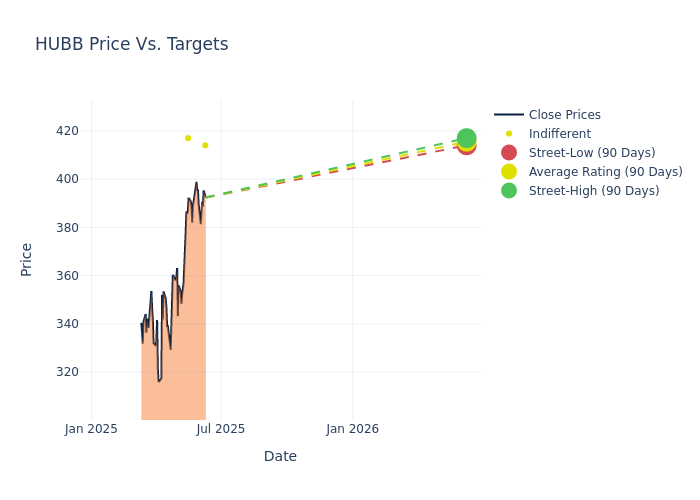
Throughout the last three months, 4 analysts have evaluated Hubbell (NYSE:HUBB), offering a diverse set of opinions from bullish to bearish.
The table below summarizes their recent ratings, showcasing the evolving sentiments within the past 30 days and comparing them to the preceding months.
| Bullish | Somewhat Bullish | Indifferent | Somewhat Bearish | Bearish | |
|---|---|---|---|---|---|
| Total Ratings | 0 | 0 | 4 | 0 | 0 |
| Last 30D | 0 | 0 | 1 | 0 | 0 |
| 1M Ago | 0 | 0 | 1 | 0 | 0 |
| 2M Ago | 0 | 0 | 0 | 0 | 0 |
| 3M Ago | 0 | 0 | 2 | 0 | 0 |
Analysts provide deeper insights through their assessments of 12-month price targets, revealing an average target of $395.75, a high estimate of $417.00, and a low estimate of $352.00. A negative shift in sentiment is evident as analysts have decreased the average price target by 1.31%.

Diving into Analyst Ratings: An In-Depth Exploration
The standing of Hubbell among financial experts becomes clear with a thorough analysis of recent analyst actions. The summary below outlines key analysts, their recent evaluations, and adjustments to ratings and price targets.
| Analyst | Analyst Firm | Action Taken | Rating | Current Price Target | Prior Price Target |
|---|---|---|---|---|---|
| Julian Mitchell | Barclays | Raises | Equal-Weight | $414.00 | $400.00 |
| Stephen Tusa | JP Morgan | Raises | Neutral | $417.00 | $352.00 |
| Stephen Tusa | JP Morgan | Lowers | Neutral | $352.00 | $430.00 |
| Julian Mitchell | Barclays | Lowers | Equal-Weight | $400.00 | $422.00 |
Key Insights:
- Action Taken: In response to dynamic market conditions and company performance, analysts update their recommendations. Whether they 'Maintain', 'Raise', or 'Lower' their stance, it signifies their reaction to recent developments related to Hubbell. This insight gives a snapshot of analysts' perspectives on the current state of the company.
- Rating: Analysts unravel qualitative evaluations for stocks, ranging from 'Outperform' to 'Underperform'. These ratings offer insights into expectations for the relative performance of Hubbell compared to the broader market.
- Price Targets: Analysts provide insights into price targets, offering estimates for the future value of Hubbell's stock. This comparison reveals trends in analysts' expectations over time.
Considering these analyst evaluations in conjunction with other financial indicators can offer a comprehensive understanding of Hubbell's market position. Stay informed and make well-informed decisions with our Ratings Table.
Stay up to date on Hubbell analyst ratings.
Unveiling the Story Behind Hubbell
Founded in 1888 by Harvey Hubbell, the eponymous company was the conduit through which the pull-chain lamp socket was originally sold. Hubbell has since grown into an electricity transmission and distribution behemoth, housing more than 75 brands that sell components found on power lines, electrical substations, and within commercial and industrial buildings. The company's primary operations are within the United States, where around 90% of revenue is derived.
Breaking Down Hubbell's Financial Performance
Market Capitalization: Positioned above industry average, the company's market capitalization underscores its superiority in size, indicative of a strong market presence.
Decline in Revenue: Over the 3M period, Hubbell faced challenges, resulting in a decline of approximately -2.42% in revenue growth as of 31 March, 2025. This signifies a reduction in the company's top-line earnings. As compared to its peers, the revenue growth lags behind its industry peers. The company achieved a growth rate lower than the average among peers in Industrials sector.
Net Margin: The company's net margin is a standout performer, exceeding industry averages. With an impressive net margin of 12.41%, the company showcases strong profitability and effective cost control.
Return on Equity (ROE): The company's ROE is a standout performer, exceeding industry averages. With an impressive ROE of 5.19%, the company showcases effective utilization of equity capital.
Return on Assets (ROA): Hubbell's ROA excels beyond industry benchmarks, reaching 2.49%. This signifies efficient management of assets and strong financial health.
Debt Management: The company maintains a balanced debt approach with a debt-to-equity ratio below industry norms, standing at 0.62.
Understanding the Relevance of Analyst Ratings
Experts in banking and financial systems, analysts specialize in reporting for specific stocks or defined sectors. Their comprehensive research involves attending company conference calls and meetings, analyzing financial statements, and engaging with insiders to generate what are known as analyst ratings for stocks. Typically, analysts assess and rate each stock once per quarter.
Some analysts will also offer forecasts for metrics like growth estimates, earnings, and revenue to provide further guidance on stocks. Investors who use analyst ratings should note that this specialized advice comes from humans and may be subject to error.
Which Stocks Are Analysts Recommending Now?
Benzinga Edge gives you instant access to all major analyst upgrades, downgrades, and price targets. Sort by accuracy, upside potential, and more. Click here to stay ahead of the market.
This article was generated by Benzinga's automated content engine and reviewed by an editor.